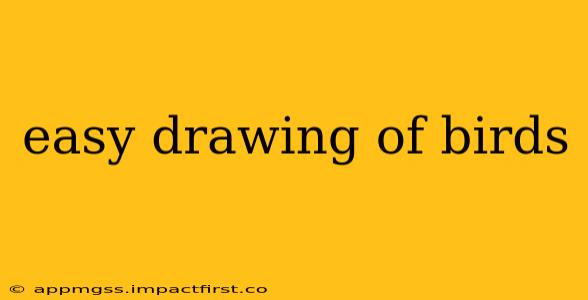Birds! Their vibrant colors, graceful flight, and diverse forms make them endlessly fascinating subjects for artists of all skill levels. This guide will walk you through easy bird drawings, perfect for beginners who want to capture the beauty of these creatures on paper. We'll cover basic shapes, simple techniques, and helpful tips to get you started on your avian artistic journey.
What are the Easiest Birds to Draw?
This is a common question for beginners! The easiest birds to draw often feature simple shapes and less intricate details. Think about birds with:
- Round bodies: Robins, sparrows, and bluebirds often have relatively round body shapes, which are easy to start with.
- Simple head shapes: Birds with round or slightly pointed heads are easier to depict than those with elaborate crests or beaks.
- Limited detail: Focusing on birds without overly complex plumage patterns allows you to concentrate on fundamental shapes and proportions.
How to Draw a Simple Bird: A Step-by-Step Guide
Let's create a basic bird drawing using simple shapes:
- Start with a circle: Draw a circle for the bird's body.
- Add the head: Attach a slightly smaller circle for the head, overlapping the body circle slightly.
- Draw the beak: Add a small triangle or a slightly curved line for the beak.
- Create the tail: Draw a simple curved line or a series of short lines for the tail.
- Add the wings: Draw two slightly curved lines extending from the sides of the body. Keep them simple; you can add more detail later.
- Draw the legs and feet: Add two short, slightly curved lines for the legs, ending in small, simplified feet.
- Erase guidelines: Carefully erase any overlapping lines or guidelines.
- Add details: Once you have the basic structure, you can add details such as eyes, feathers (using simple hatches or lines), and color.
What Materials Do I Need for Bird Drawing?
You don't need fancy materials to get started! Here's what you'll need:
- Paper: Regular drawing paper or sketch paper will work perfectly.
- Pencil: A standard HB pencil is ideal for sketching.
- Eraser: A good eraser is essential for correcting mistakes.
- Optional: Colored pencils, crayons, or markers: For adding color to your bird drawings.
How Can I Improve My Bird Drawings?
Practice is key! The more you draw, the better you'll become at capturing the essence of birds. Here are some tips to improve your skills:
- Study real birds: Observe birds in your environment or use reference photos. Pay attention to their posture, shape, and details.
- Break it down into shapes: As we did above, break down complex shapes into simpler forms (circles, triangles, etc.) to build your drawing.
- Practice perspective: Experiment with drawing birds from different angles.
- Master basic shading techniques: Simple shading can add depth and realism to your drawings.
What are Some Easy Bird Drawing Tutorials Online?
Many fantastic online resources offer easy bird drawing tutorials. A simple search for "easy bird drawings for beginners" on platforms like YouTube will reveal a wealth of step-by-step videos and guides. Experiment with different tutorials to find a style that suits your learning preferences.
How Do I Draw Different Types of Birds?
While the basic principles remain the same, different bird species will have unique characteristics. Observe the differences in beak shape, body proportions, and plumage patterns. Try drawing various birds to expand your skills and understanding of avian anatomy. For example, a majestic owl will require a different approach than a tiny hummingbird.
Are there any Tips for Drawing Realistic Birds?
To approach realism, focus on accurate proportions, detailed feather rendering, and believable shading. Study avian anatomy and consider using a variety of pencil strokes to create texture. Observe how light interacts with feathers to create highlights and shadows.
By following these steps and practicing regularly, you'll be creating beautiful and expressive bird drawings in no time. Happy drawing!
